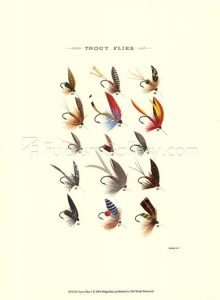Fly Fishing: Getting Started

So you’re going to take up fly fishing. You’ll need equipment. Thumbing through catalogs is fine, but before you take out the credit card and reach for the phone, consider buying a used rod and reel. New isn’t necessary. New doesn’t catch more fish. The major difference between a brand new fly rod and reel and a comparable used outfit that’s been well maintained is the packaging you get to discard. The money you save can be used for something else, like high quality waders.We’ll get to that.
A used rod should have unfrayed wrapping on the guides, and ferrules that fit well. A used reel should be free of rust, with a drag that functions properly. When you look at used equipment, take someone with you who already flyfishes. They’ll know what to look for. And don’t overlook friends and neighbors as an equipment resource. Every fly fisherman I know who’s been at it a decade or two has perfectly good fly rods and fly reels they haven’t used in years, tucked away in drawers and closets. There might be a better deal across the street than you’ll find anywhere else.
Click Here To Subscribe!
You will want new flyline. Line finishes degrade over time, making them tougher to cast. Worn fly lines also absorb water; sinking lines get too heavy and floating lines sink. I would suggest you start with just a floating weight-forward fly line. For general stream fishing, it will handle wets, dries, nymphs, and even streamers, with a little weight attached to the leader when needed. You can easily spend a hundred dollars or more on a fly line, but you can spend less than half that and still get a quality line with a good guarantee. And this is a great time of the year to find tackle on sale.
You’re going to need backing on the reel if it doesn’t already have it. Backing isn’t just extra running line in case you hook a fish that bolts to the other side of the river. Backing increases the diameter of the spool, allowing more line to be retrieved with each turn. You can put the backing and fly line on the reel yourself. If you Google “fly fishing knots” there are numerous websites that show you how to do it. If you have a fly fishing shop nearby, buy your line and backing there, and let them do this for you. Ask them to also attach a hard mono loop to the end of your fly line. The mono loop will allow easy attachment of leaders for the life of the line.
Waders are personal. You live in them when you fish. They have to fit. They have to keep you dry. If someone wants to give you their old waders, a simple no thank you will suffice. People buy new waders for one reason: Their old ones leak. There’s no item of fly fishing equipment that is more important for your comfort, and your safety, than your waders. Buy the best waders you can afford. No leak is acceptable, ever. On a warm spring day, when the water temperature is in the fifties, or even the sixties, a damp foot or knee will transition from a minor irritation, to shivering, faster than you can wade out of the stream.
Waders come in many styles. Boot foot waders that have the “shoe” built in tend to be the least expensive. If they feel right and have a reasonable guarantee, they might be all you need. If you prefer a bit more ankle support, stocking foot waders with separate wading shoes and ankle gaiters (gravel guards) might be the way to go. Whatever you choose, be sure the soles have some version of felts attached. Felts give you traction on slippery surfaces. Plain rubber soles are treacherous. Without felts, slippery rocks on the stream bottom feel like greased bowling balls.
Note that we’re talking about chest waders. Not hip boots. Hip boots have their place but wading a trout stream beyond knee deep is not one of them. Some waders have the required suspenders attached to them, some don’t. And don’t overlook the purchase of thick socks that cushion your feet and insulate you against the stream temperature. Take your time assembling your wading gear. Be sure it all fits. Put your socks and waders on and walk around in them before you buy them. They should fit as well as your shoes.
In next month’s column, I’ll discuss some other things you’ll need to get started. Have a grand New Year!
Jack Gagnon is an avid fly fisherman and upland bird hunter. He has written for a number of national sporting publications.
For more articles and stories about hunting, fishing and the outdoors, be sure to subscribe to our monthly publication the Northwoods Sporting Journal.
To access past copies of the Northwoods Sporting Journal in digital format at no charge, click here.
